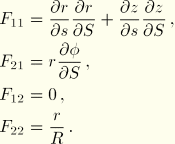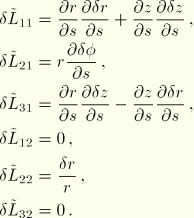
Product: ABAQUS/Standard
ABAQUS includes two libraries of axisymmetric membrane elements, MAX and MGAX, whose geometry is axisymmetric (bodies of revolution) and that can be subjected to axially symmetric loading conditions. In addition, MGAX elements support torsion loading and general material anisotropy. Therefore, MGAX elements will be referred to as generalized axisymmetric membrane elements, and MAX elements will be referred to as regular axisymmetric membrane elements. In both cases the body of revolution is generated by revolving a line that represents the membrane surface (a membrane has negligible thickness) about an axis (the symmetry axis) and is described readily in cylindrical coordinates r, z, and ![]() . The radial and axial coordinates of a point on this cross-section are denoted by r and z, respectively. At
. The radial and axial coordinates of a point on this cross-section are denoted by r and z, respectively. At ![]() , the radial and axial coordinates coincide with the global Cartesian X- and Y-coordinates.
, the radial and axial coordinates coincide with the global Cartesian X- and Y-coordinates.
If the loading consists of radial and axial components that are independent of ![]() and the material is either isotropic or orthotropic, with
and the material is either isotropic or orthotropic, with ![]() being a principal material direction, the displacement at any point will have only radial (
being a principal material direction, the displacement at any point will have only radial (![]() ) and axial (
) and axial (![]() ) components. The only nonzero stress components are
) components. The only nonzero stress components are ![]() and
and ![]() , where s denotes a length measuring coordinate along the line representing the membrane surface on any r–z plane. The deformation of any r–z plane (or, more precisely, any r–z line) completely defines the state of stress and strain in the body. Consequently, the geometric model is described by discretizing the reference cross-section at
, where s denotes a length measuring coordinate along the line representing the membrane surface on any r–z plane. The deformation of any r–z plane (or, more precisely, any r–z line) completely defines the state of stress and strain in the body. Consequently, the geometric model is described by discretizing the reference cross-section at ![]() .
.
If one allows for a circumferential component of loading (which is independent of ![]() ) and general material anisotropy, displacements and stress fields become three-dimensional. However, the problem remains axisymmetric in the sense that the solution does not vary as a function of
) and general material anisotropy, displacements and stress fields become three-dimensional. However, the problem remains axisymmetric in the sense that the solution does not vary as a function of ![]() , and the deformation of the reference r–z cross-section characterizes the deformation in the entire body. The motion at any point will have—in addition to the aforementioned radial and axial displacements—a twist
, and the deformation of the reference r–z cross-section characterizes the deformation in the entire body. The motion at any point will have—in addition to the aforementioned radial and axial displacements—a twist ![]() (in radians) about the z-axis, which is independent of
(in radians) about the z-axis, which is independent of ![]() . There will also be a nonzero in-plane shear stress,
. There will also be a nonzero in-plane shear stress, ![]() , as a result of the deformation.
, as a result of the deformation.
This section describes the formulation of the generalized axisymmetric membrane elements. The formulation of the regular axisymmetric membrane elements is a subset of this formulation.

The coordinate system used with both families of elements is the cylindrical system (r, z, ![]() ), where r measures the distance of a point from the axis of the cylindrical system, z measures its position along this axis, and
), where r measures the distance of a point from the axis of the cylindrical system, z measures its position along this axis, and ![]() measures the angle between the plane containing the point and the axis of the coordinate system and some fixed reference plane that contains the coordinate system axis. The order in which the coordinates and displacements are taken in these elements is based on the convention that z is the second coordinate. This order is not the same as that used in three-dimensional elements in ABAQUS, in which z is the third coordinate; nor is it the order (r,
measures the angle between the plane containing the point and the axis of the coordinate system and some fixed reference plane that contains the coordinate system axis. The order in which the coordinates and displacements are taken in these elements is based on the convention that z is the second coordinate. This order is not the same as that used in three-dimensional elements in ABAQUS, in which z is the third coordinate; nor is it the order (r, ![]() , z) that is usually taken in cylindrical systems.
, z) that is usually taken in cylindrical systems.
Let ![]() ,
, ![]() , and
, and ![]() be unit vectors in the radial, axial, and circumferential directions at a point in the undeformed state, as shown in Figure 3.2.8–1.
be unit vectors in the radial, axial, and circumferential directions at a point in the undeformed state, as shown in Figure 3.2.8–1.
![]()
The current position, ![]() , of the point can be represented in terms of the current radius, r, and the current axial position, z, as
, of the point can be represented in terms of the current radius, r, and the current axial position, z, as
![]()

The following isoparametric interpolation scheme is used for the motion:


For a material point the deformation gradient ![]() is defined as the gradient of the current position,
is defined as the gradient of the current position, ![]() , with respect to the original position,
, with respect to the original position, ![]() , and is given by
, and is given by
The components of the deformation gradient require that two sets of orthonormal basis vectors be defined. In the undeformed configuration the basis vectors are defined by
![]()
![]()
![]()
![]()


As discussed in “Equilibrium and virtual work,” Section 1.5.1, the formulation of equilibrium (virtual work) requires the virtual velocity gradient, which takes the form
![]()
![]()
![]()
![]()
![]()

With this modification, the corotational virtual deformation gradient is given by
![]()
![]()
